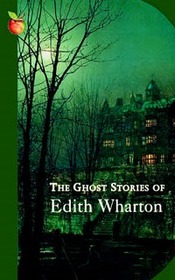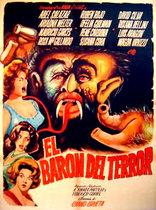Our editor-in-chief Nate Yapp is proud to have contributed to the new book Hidden Horror: A Celebration of 101 Underrated and Overlooked Fright Flicks, edited by Aaron Christensen. Another contributors include Anthony Timpone, B.J. Colangelo, Dave Alexander, Classic-Horror.com's own Robert C. Ring and John W. Bowen. Pick up a copy today from Amazon.com!
Cold Reads: Afterward by Edith Wharton
For those of you dedicated deadites who have been reading these weekly reviews, you have perhaps taken notice of an ongoing, vital factor of horror fiction that I have mentioned several times now. I am referring to that slow build up of dread and foreboding that writers use so potently in their stories. It is my belief that this is where the true terror and tension of weird fiction exists and, when in the manipulative, crafty hands of a talented scribe, it can be used to torment the reader's mind with a sense of perfect horror that is not easily forgotten. In "Afterward", a ghost story almost like no other, Edith Wharton provides us literary masochists with a great, spooky high.
The house at Lyng seems like the "perfect place" for Edward and Mary Boyne to settle down. The beautiful landscape and ideal desolation seem to be just what the couple are looking for, with Edward finally being financially set due to his long years working for the Blue Star Mine. Ah, but there's always a catch. They are informed that the estate is indeed equipped with a ghost, but not just any wandering spirit. The people who encounter the revenant are never initially aware that they are facing a ghost; they are only conscious of the haunting until long, long afterward.
These circumstances are certainly strange, but not so much stranger than Edward's slightly distressed behavior and the sightings of a strange man walking on the grounds. When Edward mysteriously disappears after consulting with a traveler who called for him, Mary begins to become knowledgeable of her husband's cutthroat business methods and the frightening impact it has taken on their lives.
Wharton crafts every aspect of the story perfectly, each new revelation or plot point set up to build the tale's suspense and heighten the reader's anxiety. This starts right from the story's beginning; the main characters (and we the readers) are told that the presence of the ghost will only make itself known until long afterward of its actual appearance. This causes us to be on the lookout, so to speak. This setup has perfectly tuned in our senses for the spirit's arrival and we wait anxiously for the phantom to come forth from the dark side. Wharton already has us eating out of the palm of her hand and it's long before the supernatural element of the story even makes itself known.
We also have no idea what to expect. We are additionally told in the beginning that there is no legend to accompany the specter, no backstory to give us any clue as to the ghost's origins or motives. The myth of the haunting is an integral part of any ghost story, but Wharton's complete disregard for this component both shocks our sense of conventions and compels our immediate interest. The story's climax makes the absence of a legend understandable within the context of the tale.
NOTE: The ending of the story will be revealed in the following paragraphs. If you wish to read it for yourself, it's available online. However, if you are one who cares little for surprise endings, please read on. And be ashamed of yourself.
The spirit that is haunting the house at Lyng is one Robert Elwell, a colleague of Edward's in the Blue Star Mine. It seems that Edward and Robert had gotten wind of a sure-fire way to earn big money and move up in the company. Boyne, not having any sympathy for his partner, made the first move and enjoyed the glories of his new position. Elwell was left in the dust, financially destroyed. Elwell tried to bring the matter to court, but it soon became apparent that he didn't stand a chance legally against Boyne. Devastated at his unfortunate circumstances, Elwell attempted to end his life at the business end of a gun. It took almost a month for him to finally pass away.
The shocking revelation is essential in understanding some of the story's important themes concerning the human condition. It was greed that ultimately created and summoned the spirit to arrive in the first place. Edward was solely concerned with his own self-interest and held little care for the fortune of others. It was this character flaw that invariably led Elwell to kill himself and thus send his spirit out into the world to seek retribution. The house at Lyng served as a magnet for the tortured soul, calling it from the depths of the grave and Boyne's shady past to mete out its final justice.
Mary equates the house to a silent watcher, a vessel that brings forth the spirit and allows the dead to carry on their business without further interference. This doesn't necessarily mean that the house at Lyng is a portal of unholy evil. Ironically, Edward's backstabbing and the calm, cool manner in which his lawyer details the gruesome affair later to Mary seem to be the most diabolical elements of the story. Ghosts are reflections of ourselves, the spectral mirrors that reveal to us all the evils and corruption our souls contain.
Up until the conclusion, the events of the story unfold in that beautifully slow and meticulous way that never states explicitly if the characters are truly encountering the supernatural or giving in to the frailties of their own minds. Edward is plagued by the guilt of his actions, his constantly distressed manner expressed in bouts of silence and melancholy. This leads his wife Mary to become paranoid and suspicious of his actions. She knows there is something troubling her husband's mind, something he never fully lets her on to.
This creates a sense of paranoia in us as well. What is Edward's secret? What is he keeping from Mary? Why does he respond so erratically to the sighting of the man on the property? This may sound like the usual sort of character development that is needed for a story of ghostly revenge, but it serves a higher purpose than merely "giving a reason" for Elwell's spirit to show up. Wharton twists the usual trappings and rules of the ghost story to fit her own needs, making it a freshly unique and complex approach to the typical yarn of the haunters and the haunted.
Wharton also writes a scene of great juxtaposition halfway into the story. On a beautiful autumn afternoon, Mary decides to busy herself by going out into the garden to survey her magnificent flora. The day is bright and bountiful, the luscious colors of all the flowers and the sprawling countryside meeting her admiring eye. This goes on for about a page or so and the reader (as I myself did) may find all of this very pointless. Perhaps this is exactly what Wharton wants you to think. Because it is then that she decides to make things much more interesting. Mary suddenly becomes aware of a traveler making his way towards the house. He is a drab looking sort, everything about his wardrobe and very presence giving the impression of a gray shadow. A wide-brimmed hat hides most of his face, adding to the feeling of his invisibility.
As you've probably already guessed, this is Elwell in the not-so-much flesh. His appearance in this scene suddenly takes the mood in an entirely different direction. Again, Wharton sets us up only to knock us down with a surprise attack. The description of the majestic garden and environment is utilized in order to emphasize the numbing effect that Elwell has on the atmosphere. Whereas the flowers are symbols of life and beauty, Elwell seems to be a gross fungus, a dreary blot whose lack of vitality stands out from the rest of his surroundings. When he speaks to Mary, his questions and answers are quick and elusive, making his motives even more mysterious. He is a deceased creature fueled by a sole purpose, one that is the only link connecting him to the physical world. The details of the radiant setting make Elwell's presence significantly more dreadful and foreboding.
Ghost stories are a dime a dozen. It is very easy to run into one that is lacking in atmosphere or one that goes through the tried and true motions of the stereotypical campfire tale. However, if you are truly lucky, you will discover that ebony, deaths-head diamond in the rough that will make all your poltergeist-related endeavors meaningful. Edith Wharton has supplied the world with a ghost story that will thrill and chill the spines of readers of every creed. Perhaps the most terrifying thing about "Afterward", though, is not the face you see in the darkness at the top of the stairs, but rather that evil countenance that stares back at you from the reflection of the looking-glass.









Thanks for shining some light
Thanks for shining some light on this Jose! I Just finished reading the story, and really enjoyed it. Your article, as always, is dead on.
This story has always
This story has always reminded me of Henry Wilcox in EM Forster's Howard's End. When it comes down to it, I think the story (and Forster's novel) are about class--how one obtains status, the ways in which we'll sacrifice others to achieve financial security. These types of novels and stories are even more poignant living today during the current financial crisis.
(Having said this, I must also say that being poor seems to be an antidote the terror induced by the financial crisis. I have nothing; therefore, I lose nothing. Poor, wealthy saps.)